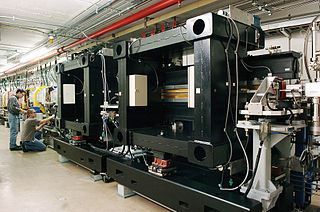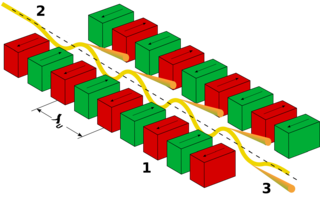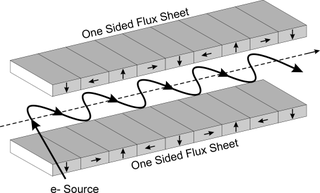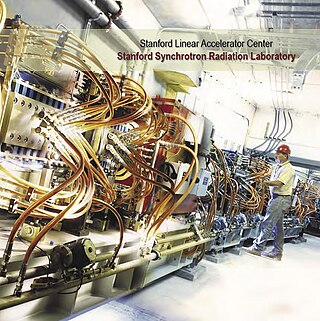
Herman Winick (born June 27, 1932) is an American scientist and Professor Emeritus at the Stanford Linear Accelerator Center (SLAC) and the Applied Physics Department of Stanford University.

Herman Winick (born June 27, 1932) is an American scientist and Professor Emeritus at the Stanford Linear Accelerator Center (SLAC) and the Applied Physics Department of Stanford University.
After receiving his AB (1953) and PhD (1957) in physics from Columbia University, he continued work in experimental high energy physics at the University of Rochester (1957–59) and then as a member of the scientific staff and Assistant Director of the Cambridge Electron Accelerator at Harvard University (1959–73).
Dr. Winick married his childhood sweetheart Renee Winick and is the father of three children; Lee, Lisa and Laura. He is the grandfather of seven, including youtube celebrity Julien Solomita who is the husband of Jenna Marbles.
He is best known for his leadership role, starting in the mid-1970s, in the development of wiggler and undulator magnet insertion devices as advanced synchrotron radiation sources. [1] [2]
Since retirement he is focusing largely on synchrotron light sources in developing countries such as the International Centre for Synchrotron-Light for Experimental Science Applications in the Middle East (SESAME), work he began in 1998, [1] the African Light Source and the Mexican Light Source.
His human rights activities started in the 1980s working on behalf of dissidents from the China, Iran, the Soviet Union, and other countries. [1]
In 2005 he received the Heinz R. Pagels Human Rights of Scientists Award from the New York Academy of Sciences.
Winick received the third Andrei Sakharov Prize from the American Physical Society (APS) in 2010 "for tireless and effective personal leadership in defense of human rights of scientists throughout the world". [1] [3]

SLAC National Accelerator Laboratory, originally named the Stanford Linear Accelerator Center, is a federally funded research and development center in Menlo Park, California, United States. Founded in 1962, the laboratory is now sponsored by the United States Department of Energy and administrated by Stanford University. It is the site of the Stanford Linear Accelerator, a 3.2 kilometer (2-mile) linear accelerator constructed in 1966 that could accelerate electrons to energies of 50 GeV.

Burton Richter was an American physicist. He led the Stanford Linear Accelerator Center (SLAC) team which co-discovered the J/ψ meson in 1974, alongside the Brookhaven National Laboratory (BNL) team led by Samuel Ting for which they won Nobel Prize for Physics in 1976. This discovery was part of the November Revolution of particle physics. He was the SLAC director from 1984 to 1999.

Diamond Light Source is the UK's national synchrotron light source science facility located at the Harwell Science and Innovation Campus in Oxfordshire.

An insertion device (ID) is a component in modern synchrotron light sources, so called because they are "inserted" into accelerator tracks. They are periodic magnetic structures that stimulate highly brilliant, forward-directed synchrotron radiation emission by forcing a stored charged particle beam to perform wiggles, or undulations, as they pass through the device. This motion is caused by the Lorentz force, and it is from this oscillatory motion that we get the names for the two classes of device, which are known as wigglers and undulators. As well as creating a brighter light, some insertion devices enable tuning of the light so that different frequencies can be generated for different applications.

A synchrotron is a particular type of cyclic particle accelerator, descended from the cyclotron, in which the accelerating particle beam travels around a fixed closed-loop path. The magnetic field which bends the particle beam into its closed path increases with time during the accelerating process, being synchronized to the increasing kinetic energy of the particles. The synchrotron is one of the first accelerator concepts to enable the construction of large-scale facilities, since bending, beam focusing and acceleration can be separated into different components. The most powerful modern particle accelerators use versions of the synchrotron design. The largest synchrotron-type accelerator, also the largest particle accelerator in the world, is the 27-kilometre-circumference (17 mi) Large Hadron Collider (LHC) near Geneva, Switzerland, built in 2008 by the European Organization for Nuclear Research (CERN). It can accelerate beams of protons to an energy of 13 tera electronvolts (TeV or 1012 eV).

An undulator is an insertion device from high-energy physics and usually part of a larger installation, a synchrotron storage ring, or it may be a component of a free electron laser. It consists of a periodic structure of dipole magnets. These can be permanent magnets or superconducting magnets. The static magnetic field alternates along the length of the undulator with a wavelength . Electrons traversing the periodic magnet structure are forced to undergo oscillations and thus to radiate energy. The radiation produced in an undulator is very intense and concentrated in narrow energy bands in the spectrum. It is also collimated on the orbit plane of the electrons. This radiation is guided through beamlines for experiments in various scientific areas.

A free-electron laser (FEL) is a fourth generation light source producing extremely brilliant and short pulses of radiation. An FEL functions much as a laser but employs relativistic electrons as a gain medium instead of using stimulated emission from atomic or molecular excitations. In an FEL, a bunch of electrons passes through a magnetic structure called an undulator or wiggler to generate radiation, which re-interacts with the electrons to make them emit coherently, exponentially increasing its intensity.

The Canadian Light Source (CLS) is Canada's national synchrotron light source facility, located on the grounds of the University of Saskatchewan in Saskatoon, Saskatchewan, Canada. The CLS has a third-generation 2.9 GeV storage ring, and the building occupies a footprint the size of a Canadian football field. It opened in 2004 after a 30-year campaign by the Canadian scientific community to establish a synchrotron radiation facility in Canada. It has expanded both its complement of beamlines and its building in two phases since opening. As a national synchrotron facility with over 1000 individual users, it hosts scientists from all regions of Canada and around 20 other countries. Research at the CLS has ranged from viruses to superconductors to dinosaurs, and it has also been noted for its industrial science and its high school education programs.

A wiggler is an insertion device in a synchrotron. It is a series of magnets designed to periodically laterally deflect ('wiggle') a beam of charged particles inside a storage ring of a synchrotron. These deflections create a change in acceleration which in turn produces emission of broad synchrotron radiation tangent to the curve, much like that of a bending magnet, but the intensity is higher due to the contribution of many magnetic dipoles in the wiggler. Furthermore, as the wavelength (λ) is decreased this means the frequency (ƒ) has increased. This increase of frequency is directly proportional to energy, hence, the wiggler creates a wavelength of light with a larger energy.

The Stanford Synchrotron Radiation Lightsource, a division of SLAC National Accelerator Laboratory, is operated by Stanford University for the Department of Energy. SSRL is a National User Facility which provides synchrotron radiation, a name given to electromagnetic radiation in the x-ray, ultraviolet, visible and infrared realms produced by electrons circulating in a storage ring at nearly the speed of light. The extremely bright light that is produced can be used to investigate various forms of matter ranging from objects of atomic and molecular size to man-made materials with unusual properties. The obtained information and knowledge is of great value to society, with impact in areas such as the environment, future technologies, health, biology, basic research, and education.

Electron scattering occurs when electrons are displaced from their original trajectory. This is due to the electrostatic forces within matter interaction or, if an external magnetic field is present, the electron may be deflected by the Lorentz force. This scattering typically happens with solids such as metals, semiconductors and insulators; and is a limiting factor in integrated circuits and transistors.
Joachim Stöhr is a physicist and professor emeritus of the Photon Science Department of Stanford University. His research has focused on the development of X-ray and synchrotron radiation techniques and their applications in different scientific fields with emphasis on surface science and magnetism. During his career he also held several scientific leadership positions, such as the director of the Stanford Synchrotron Radiation Laboratory (SSRL) and he was the founding director of the Linac Coherent Light Source (LCLS), the world's first x-ray free electron laser.
The Andrei Sakharov Prize is a prize that is to be awarded every second year by the American Physical Society since 2006. The recipients are chosen for "outstanding leadership and/or achievements of scientists in upholding human rights". The prize is named after Andrei Sakharov (1921-1989), Soviet nuclear physicist, dissident and human rights activist; since 2007 it has been valued at $10,000. The first Sakharov Prize was awarded to physicist and former Soviet gulag prisoner Yuri Orlov.
The Committee on Human Rights of Scientists of the New York Academy of Sciences "was formed in 1978 to pursue the advancement of the basic human rights of scientists throughout the world. The Committee intervenes in cases where scientists, engineers, health professionals and educators are detained, imprisoned, exiled, murdered, "disappeared," or deprived of the rights to pursue science, communicate their findings with their peers and the general public, and travel freely in accordance with established policies of The International Council for Science (ICSU)."

A particle accelerator is a machine that uses electromagnetic fields to propel charged particles to very high speeds and energies, and to contain them in well-defined beams.
The Hiroshima Synchrotron Radiation Center, also known as Hiroshima Synchrotron Orbital Radiation (HiSOR), at Hiroshima University is a national user research facility in Japan. It was founded in 1996 by the University Science Council at Hiroshima University initially as a combined educational and research facility before opening to users in Japan and across the world in 2002. It is the only synchrotron radiation experimental facility located at a national university in Japan. The HiSOR experimental hall contains two undulators that produce light in the ultraviolet to soft x-ray range. A total of 16 beamlines are supported by bending magnet and undulator radiation for use in basic studies of life sciences and physical sciences, especially solid-state physics.

Claudio Pellegrini is an Italian/American physics and emeritus professor at University of California, Los Angeles (UCLA), known for his pioneering work on X-ray free electron lasers and collective effects in relativistic particle beams.
Evert Ingolf Lindau is a Swedish physicist and professor emeritus at Lund University and Stanford University and a member of the Royal Swedish Academy of Sciences.

SOLARIS is the only synchrotron in Central-Eastern Europe. Built in Poland in 2015, under the auspices of the Jagiellonian University, it is located on the Campus of the 600th Anniversary of the Jagiellonian University Revival, in the southern part of Krakow. It is the central facility of the National Synchrotron Radiation Centre SOLARIS.
Alexander Wu Chao is a Taiwanese-American physicist, specializing in accelerator physics.